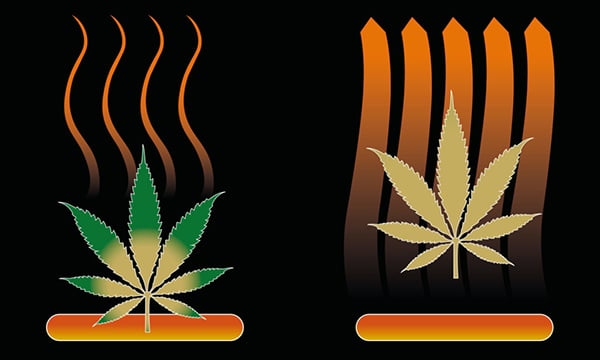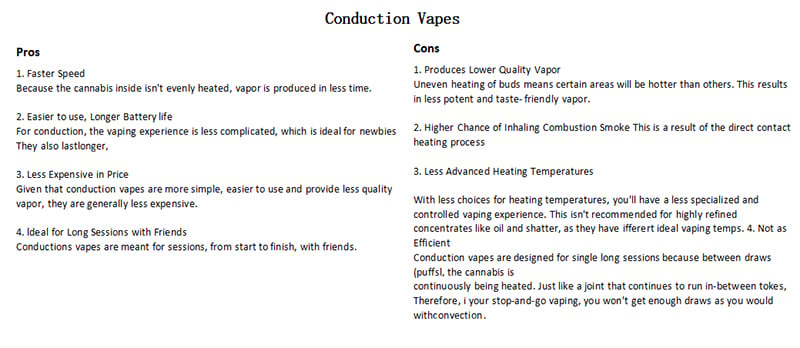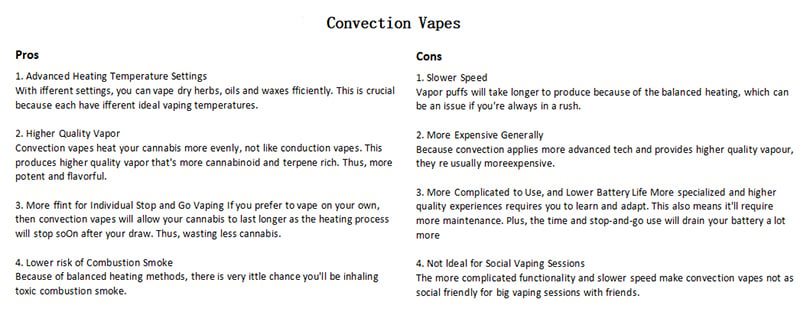Convection Vs. Conduction Cannabis Vaping
Convection Vs. Conduction Cannabis Vaping

People who are new to vaping cannabis are often overwhelmed by all the devices on the market today. From large, bulky desktop devices to portable vapes that fit in your palm, there are many devices for vaping marijuana.
While you can categorize dry herbal evaporators in a variety of ways, the easiest way is to classify these devices as convection or conduction.
These terms refer to the standard heating methods used in dried herb vapes. There is a significant difference in the vapor quality produced by conduction and convection units, so new customers must understand what they are getting when choosing their first unit.
The Basics of Convection and Conduction Vapes

The best way to explain conduction and convection heating is to think of a frying pan versus an oven.
First, imagine throwing a steak into a frying pan.
What makes the meat sizzle? Well, the heat from the pan is transferred directly to the meat through conduction.
The heat of the pan is directly transferred. Conduction vapes are similar. The herb is placed in the chamber, and the heat transfer is direct from contact between the chamber's walls and the herb.
In these devices, the heating element touches your herb and heats it to produce vapor.
In contrast, most people compare convection devices to "baking in an oven." The heat in a convection oven will swirl around.
This flow of hot air soundings whatever is being baked and transfers to it that way.
This principle also applies to dry herb convection vapes.
Heat is generated in a separate compartment and passed through the herb chamber, heating the herb as it goes.
Conduction used to be the only heating method available in dried herb vapes. Still, with the invention of convection devices, conduction vaping has lost some of its "steam."
People often consider convection units the "cleaner" option because heating units don't directly contact the herb.

Does Convective Provide a Better Vaping Experience?
From our brief description of convection versus conduction, you might think that convection vapes are the "better" choice. Indeed, many in the cannabis vaping community believe that convection devices provide a more "premium" experience. So why would anyone bother with a conduction vape device?
Convection vapes tend to produce a smoother, tastier vaping experience. There is also no risk of burning the cannabis flowers in convection units compared to conduction ovens. Thirdly, conduction vapes heat the herb more evenly than conduction devices.
However, many vape enthusiasts still prefer the affordability and speed of conduction vaporizers. Conduction vape devices generally take less time than convection devices to reach the desired temperature. Conduction vapes also tend to have more precise temperature control.
Convection units are more complex and usually larger than conduction vapes.
Most of the time, if you can hold the vape in your hand, then it likely uses conduction heating. This makes conduction devices more popular with those who want a discreet and portable vape experience.
As you can imagine, the simpler conduction technology means these devices cost less than convection devices.
Those new to marijuana vapes often try conduction devices before deciding whether to invest the extra expense in a convection heating device. In general, conduction devices are great for "getting the job done" on the fly. At the same time, convection vapes provide a premium experience that users generally enjoy at home or with friends in a party-type scenario.
Looking for a marijuana vape?
Finding dried herb vaporizers across the United States is getting more accessible. However, some customers still need help finding high-quality vapes near them.
Fortunately, most of the top branded vapes are available to buy online, so if your local smoke shop still needs to get what you're looking for, then head to a reputable online retailer. You should be able to find what you're after.
